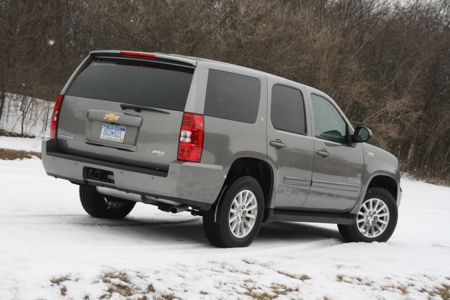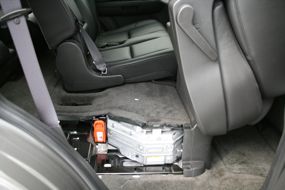Click the Tahoe hybrid for a high-res gallery
General Motors has had a checkered relationship with hybrids in the last few years. Through the 1990s they did a lot of development work in the area, particularly through the federally funded Partnership for a New Generation of Vehicles (PNGV). Ultimately, Toyota and Honda were the first to actually bring hybrid electric drivetrains to market. GM eventually brought their first light duty hybrid system to market with the mild parallel hybrid that was offered on the Silverado and Sierra pickups for a couple of years. That was followed by the belt-alternator-starter system that debuted in late 2006 on the Saturn Vue. Neither of these systems could in any way be considered a commercial success although GM claims to have learned some real world lessons from them.
Late in 2007, GM finally launched production of the Chevy Tahoe and GMC Yukon hybrids, the company's first "strong" or full hybrid systems offered on light duty vehicles. The hybrid full-size SUVs have been controversial among hybrid fans who are of course dubious about why GM is bothering to apply this technology to these big, heavy vehicles. Even with the hybrid system, the rear wheel drive Tahoe still only manages an EPA combined rating of 21 mpg, less than half of the 46 mpg that a Prius gets. There is, however, a method to the apparent madness which we'll come back to. Previously we've had a couple of opportunities for short drives of the Tahoe hybrid at GM's Milford Proving Ground. Now that we've had a chance to live with it for a week you can read all about it after the jump.
Photos Copyright ©2008 Sam Abuelsamid / Weblogs, Inc.

The Tahoe (and it's GMC Yukon twin) are the first light duty applications of GM's Two-Mode hybrid system that was originally developed for transit buses by Larry Nitz and his engineering team at GM's Allison Transmission division in the late '90s(BTW Allison was sold off last year, but GM kept the intellectual property rights to the Two-Mode system). The bus system debuted in 2003. As we all know by now, non-plug-in parallel hybrids provide their biggest benefit during stop and go driving when they can capitalize on the deceleration to recapture kinetic energy and charge the battery. During these conditions, the battery maintains a higher state of charge allowing it to provide pure electric drive and electric boost.
During higher speed highway driving the batteries typically provide relatively little benefit, most of which comes from having a more efficient base engine. This is one area where the Two-Mode system holds an advantage over other hybrids. The original bus version of the system derived its name from having two different gear ratio ranges for electronically variable transmission (EVT). All the current strong hybrids use a planetary gear EVT as does this one. The GM system has a second planetary gear set providing a wider operating range for the hybrid functionality. When GM adapted the system to light duty vehicles they also added in an extra clutch that allows the power flow to bypass the electric motors at higher speeds, running directly through the more efficient mechanical gears. In actual implementation, the full powertrain of the Tahoe actually has a lot more than two modes which we'll get back to later.

The Tahoe is, without a doubt, a big vehicle, a much bigger vehicle than the vast majority of people actually need. When GM announced the hybrid SUVs, green car fans groaned at thought of hybrid technology being "wasted" on a nearly three ton truck. But there is a method to GM's "madness." Most full hybrids get anywhere from 25-35 percent better efficiency than conventional equivalents. The problem is that as the starting mileage increases, the same percentage increase provides progressively lower fuel savings. For a Tahoe going from 16 mpg to 21 mpg, driving 15,000 miles a year will save 223 gallons. Going from 30 mpg to 39 mpg only saves 121 gallons annually. Admittedly, the Tahoe still uses a lot more fuel overall, but the savings are impressive nonetheless. Even at $3.50 a gallon there are still many people who need or want a full size SUV. If someone insists on driving such a large vehicle, at least they will make a significant dent in their fuel consumption with a hybrid version.


Unlike the first two rows of seats, the third row suffers compared to some competitors. The Tahoe (and the entire GMT900 lineup) use a solid rear axle. As a result, the floor pan needs to be higher up to provide clearance for movement of the rear differential. GM's own Lambda platform CUVs are similar in size to the Tahoe but use an

So just how well does the the Tahoe hybrid work? So far most of what I've said applies as much to a standard Tahoe as it does to the hybrid. In the past few months I've driven the Toyota Highlander, Lexus LS600h and Tahoe hybrids, all during a particularly cold Michigan winter. In the two previous cases it seemed that the vehicles were somewhat reluctant to run in electric only mode and shut off the engine infrequently when coming to a stop. While driving those vehicles, the temperatures stayed pretty frigid. Not so with the Tahoe. Most of the mornings that the Tahoe was in the ABG garage, the overnight temperatures dipped into the low teens or single digits. By mid-day, the temperatures rose into the mid thirties.


It's kind of spooky rolling along in such a big heavy vehicle in almost complete silence. Even when the engine is running the Tahoe hybrid is quieter than a standard version. In order to minimize the difference between electric and engine on operation, GM put a lot effort into minimizing NVH from all the vehicle systems and it clearly worked. We're not talking Lexus-like isolation, but the Tahoe was definitely smoother and quieter than the Highlander. The engine starts and stops are very smooth with none of the shuddering apparent on smaller front wheel drive hybrids. Maneuvering such a large vehicle requires a significant adjustment for someone used to smaller cars. The Tahoe has a rear backup camera and the large mirrors provide good visibility to the sides, but there are still plenty of blind spots. Changing lanes or pulling into tight parking spaces definitely requires extra care.

During the time I drove the Tahoe hybrid it averaged just shy of 20mpg which is a remarkable achievement for such a big heavy vehicle with the capability to tow 6,000 pounds. During the first day I had it when the weather was warmer, it actually got up to 22.5 mpg but for the remainder of the week, the frigid temperatures often limited the usefulness of the electric drive. The driver information center in the instrument cluster can display whether the engine is running on four or eight cylinders while the main screen in the center stack displays the power flow between engine, battery and wheels. Even in cold temperatures, an easy gas foot can leave the engine running in four cylinder mode much of the time.
The Two-mode branding is actually somewhat mis-leading since this system actually has many more operating modes. With the various combinations of four and eight cylinder running, electric drive, two EVT ranges, and highway cruising, the permutations seem endless. Reports of from other people who have driven the Two-mode SUVs have indicated that it's not hard to achieve 23 mpg or more in warmer temperatures. One other reviewer actually claimed to have achieved 26 mpg in a week of driving. I have to admit still being skeptical of that one, but in the right conditions it certainly seems possible. Even with the 20 mpg I got, the Tahoe handily beats anything else in its class including GM's own Lambda CUVs (Saturn Outlook, GMC Acadia and Buick Enclave).
If you don't actually need such a gargantuan vehicle, I would still suggest going for something smaller and lighter. After all, you don't need a Tahoe to schlep two or three kids to school and swing by Whole Foods. If you live in more northern climates with even colder, longer winters than Michigan had this year, you might want to hold off to see if GM offers the new 4.5L diesel V-8 in the SUVs next year. In extreme cold that might be better option than the hybrid. The Texans who build the Tahoe and Yukon at GM's Arlington assembly plant won't have to worry about single digit or sub-zero temperatures very often.


Photos Copyright ©2008 Sam Abuelsamid / Weblogs, Inc.


Sign in to post
Please sign in to leave a comment.
Continue